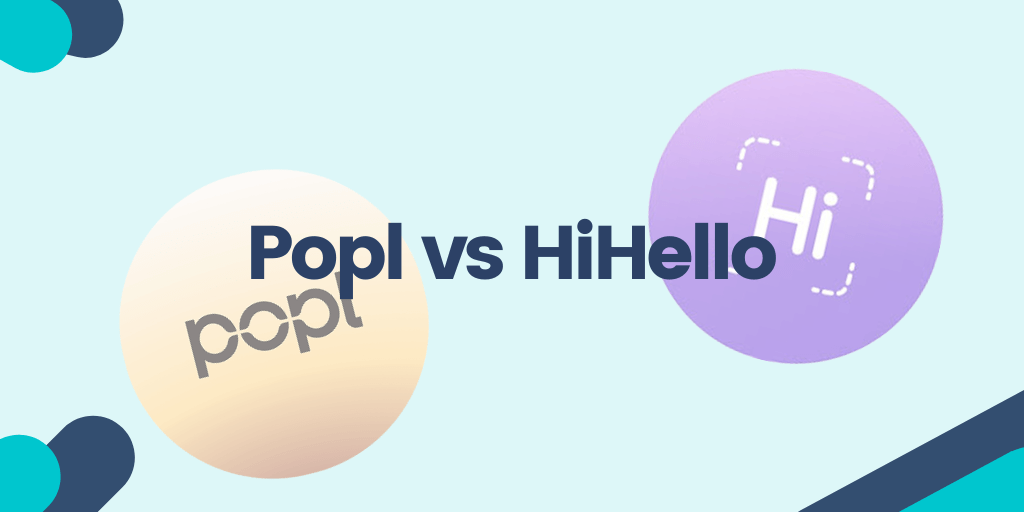Choosing between HiHello vs Popl can feel like comparing two perfectly polished business suits: both look great, but only one truly fits your team. Whether you’re tired of juggling paper cards, hunting for a smarter way to share contact details, or searching for a scalable digital solution that actually works, this guide cuts through the marketing fluff.
We’ve tested both platforms, analyzed real user feedback, and broken down everything—from pricing and features to usability and value. By the end, you’ll know exactly which comprehensive digital business card platform deserves a spot in your tech stack!
Contents:
- Why Compare Popl and HiHello
- Overview of Popl and HiHello
- Key Features and Capabilities
- Ease of Use
- Pricing
- Integrations and Compatibility
- Customer Support and Reliability
- Pros and Cons
- FAQ
Why Compare Popl and HiHello
Choosing a digital business card platform extends beyond swapping paper for pixels. At the end of the day, you’re selecting a system to represent your brand every time your team makes a new connection.
In a market crowded with options, two names consistently stand out: Popl and HiHello. Both promise sleek design, seamless contact sharing, and enterprise-ready CRM integrations. But their differences go far deeper than a logo or an NFC business card.
For business owners and teams, investing in the right digital business card solution can shape everything from how you capture leads to how you present your brand. Comparing Popl vs HiHello ensures you understand not only what each platform offers, but also which one fits your company’s workflow, goals, and budget.
Here’s why taking the time to compare HiHello vs Popl matters:
- Finding the right fit: Every organization has its own priorities—some value automation and centralized control, others need flexibility and personalization. Comparing both platforms helps you identify the one that aligns best with your daily operations.
- Getting real value for money: Both Popl and HiHello offer tiered pricing with different digital business card features. A close comparison helps you see which plan provides the right balance between cost, performance, and scalability.
- Ensuring scalability: Whether you’re managing a small sales team or an enterprise, your digital business card app should adapt as you grow. Reviewing how each platform handles multi-user access, analytics, and CRM syncs prevents future limitations.
- Maintaining brand consistency: Every card shared is a brand impression. The right platform keeps your contact details, templates, and visual identity consistent across teams and channels.
- Streamlining lead management. From QR code sharing to AI-powered lead capture, understanding how each tool connects contacts to your systems can directly improve your conversion pipeline.
In short, comparing HiHello vs Popl is less about features on paper and more about making an informed, strategic choice. The goal is to find the platform that complements your networking style, fits your infrastructure, and drives measurable business results (without the growing pains later).
Overview of Popl and HiHello
Now that we’re all set on why it’s worth comparing Popl vs HiHello, let’s look at the two platforms themselves—what drives them, how they position themselves in the market, and what makes each one distinct before diving into their specific capabilities.
What is Popl
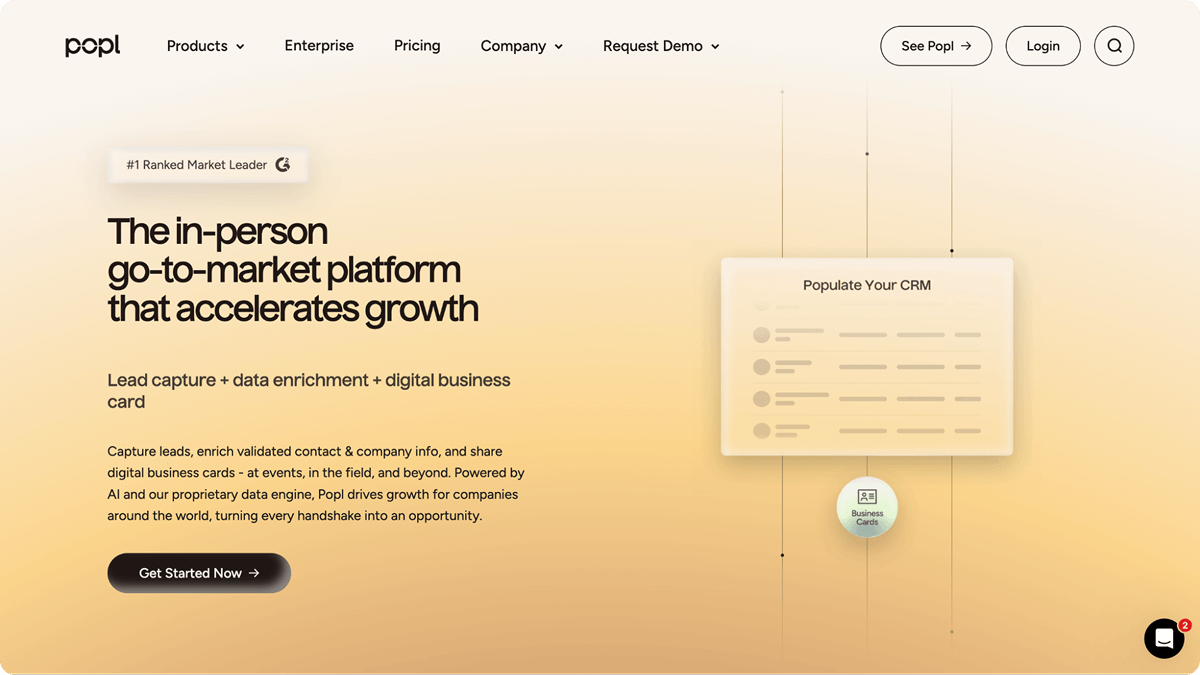
Popl began in 2020 as a tap-to-share NFC card that quickly gained traction on TikTok. Within months, it evolved from a social sharing gadget into a full-fledged digital business card platform trusted by more than 2.5 million professionals across 150 countries, including users from 90% of the Fortune 500.
Popl stands for reimagining in-person networking through technology that makes human connection easier, faster, and measurable. Rooted in its mission to connect companies with their future customers, Popl offers an all-in-one digital card solution built for teams—complete with CRM syncing, lead capture, and brand control.
With its “Human + AI” vision, Popl provides an enterprise-grade platform that blends automation with authentic interaction. Its focus on scale, usability, and data security has earned it multiple G2 awards and a 4.6/5 rating, solidifying Popl’s position as a trusted leader in the digital networking space.
What is HiHello
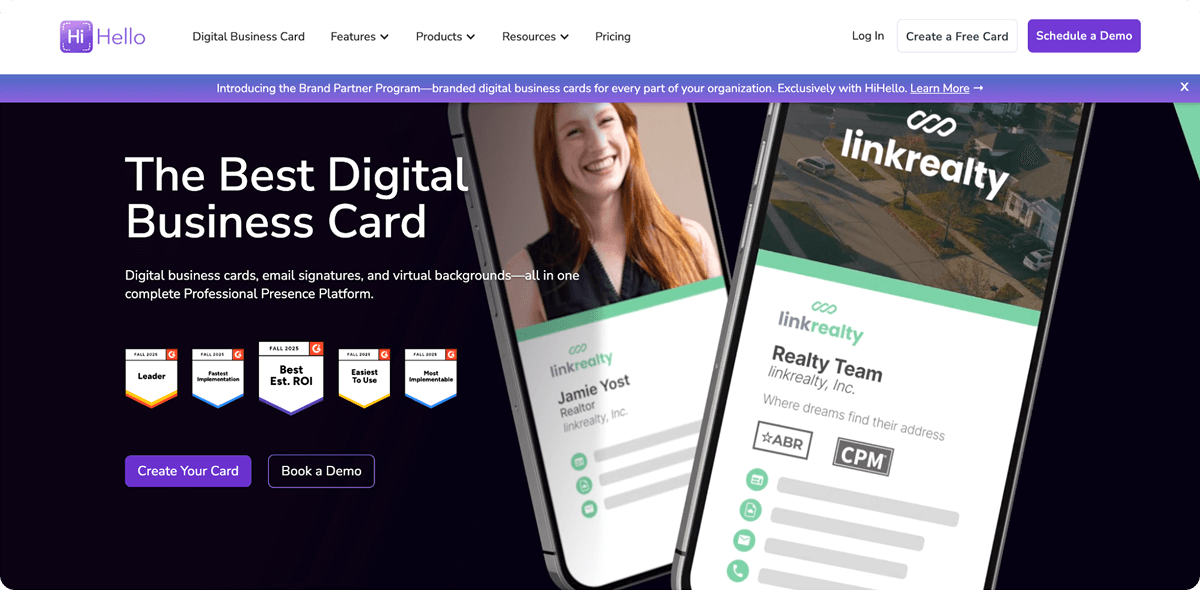
Founded in 2018 by Manu Kumar and Hari Ravi, HiHello was created to eliminate paper business cards and simplify how professionals connect. The platform evolved into a Professional Presence Platform that combines digital business cards, email signatures, virtual backgrounds, and contact management tools in one ecosystem.
Used by more than 2 million people worldwide—including professionals from Google, Meta, and Deloitte—HiHello focuses on simplicity, design consistency, and enterprise-ready data management. Its SOC 2 Type II compliance and intuitive user experience make it a preferred choice for teams that value control and clean presentation.
Rated 4.6/5 on G2, HiHello represents a modern, privacy-first approach to networking—helping businesses stay consistent, connected, and professional across every interaction.
Key Features and Capabilities
After exploring what defines Popl and HiHello, it’s time to see how each platform performs in practice. Both aim to replace traditional business cards with virtual business card systems that make networking more efficient, measurable, and aligned with modern workflows.
From card design to lead capture, the differences between the two tools become much clearer once you look at how they actually work.
Card creation and personalization
Both Popl and HiHello make creating professional cards simple—but their approaches reflect two different priorities.
HiHello offers a creative, design-forward builder that works across desktop and mobile. It’s highly customizable, giving users full control over branding. You can:
- Choose from multiple layouts and card designs
- Adjust color palettes and fonts
- Add logos, profile videos, and badges
- Embed PDFs or multimedia links
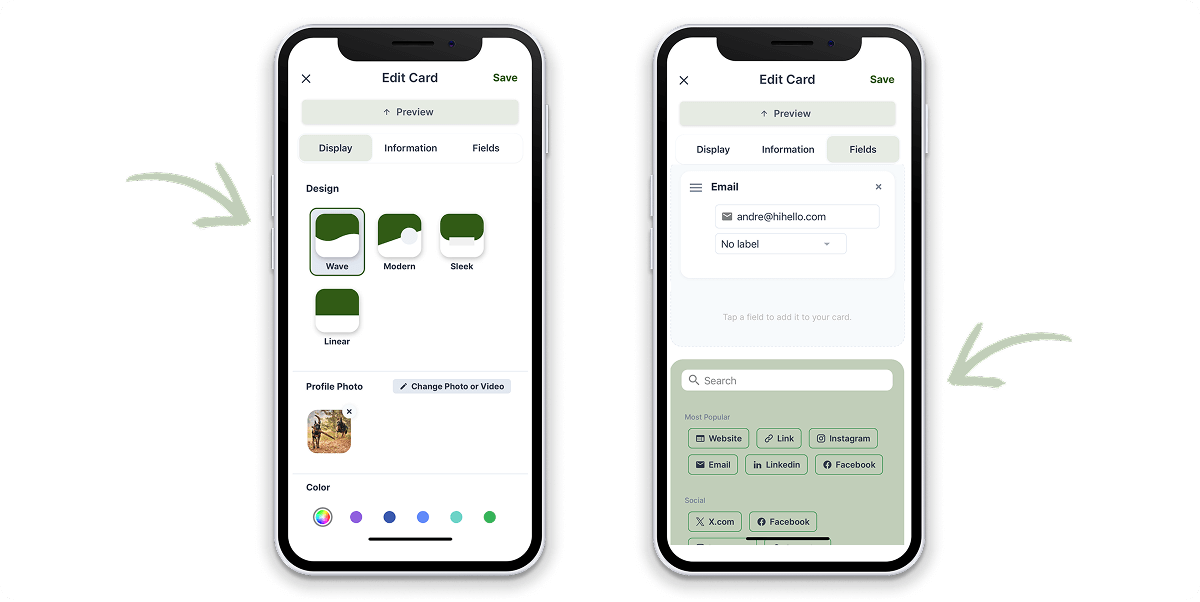
This flexibility makes it easy for individuals and teams to craft a consistent, recognizable digital identity.
Popl, on the other hand, focuses on uniformity and scalability. Admins can design templates for entire teams, locking in brand colors, layouts, and required fields to keep every card consistent.
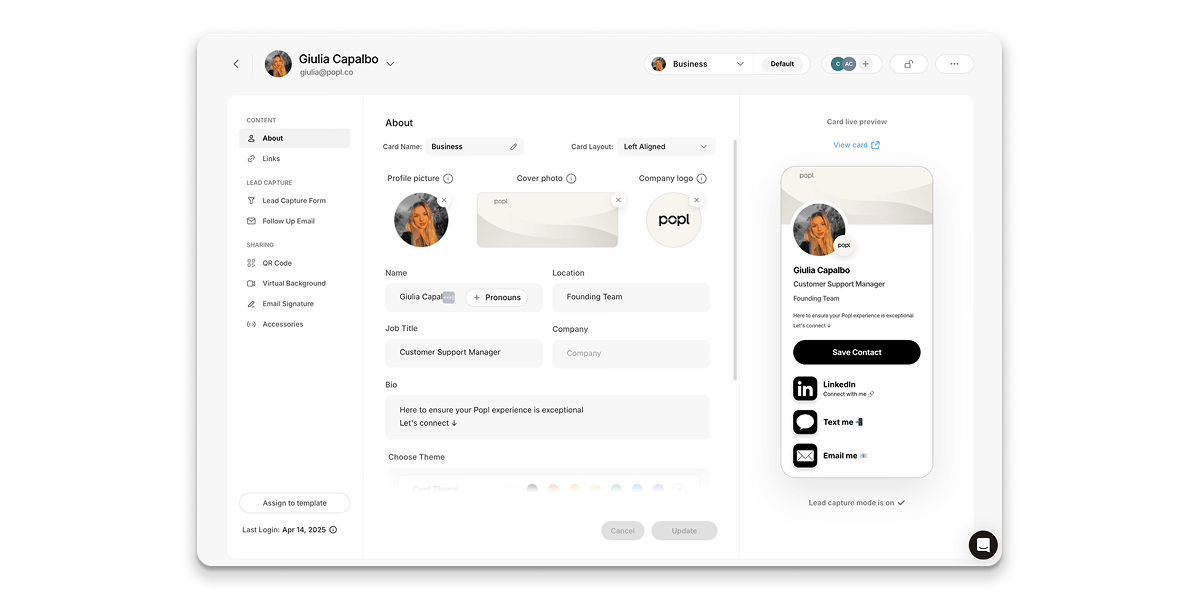
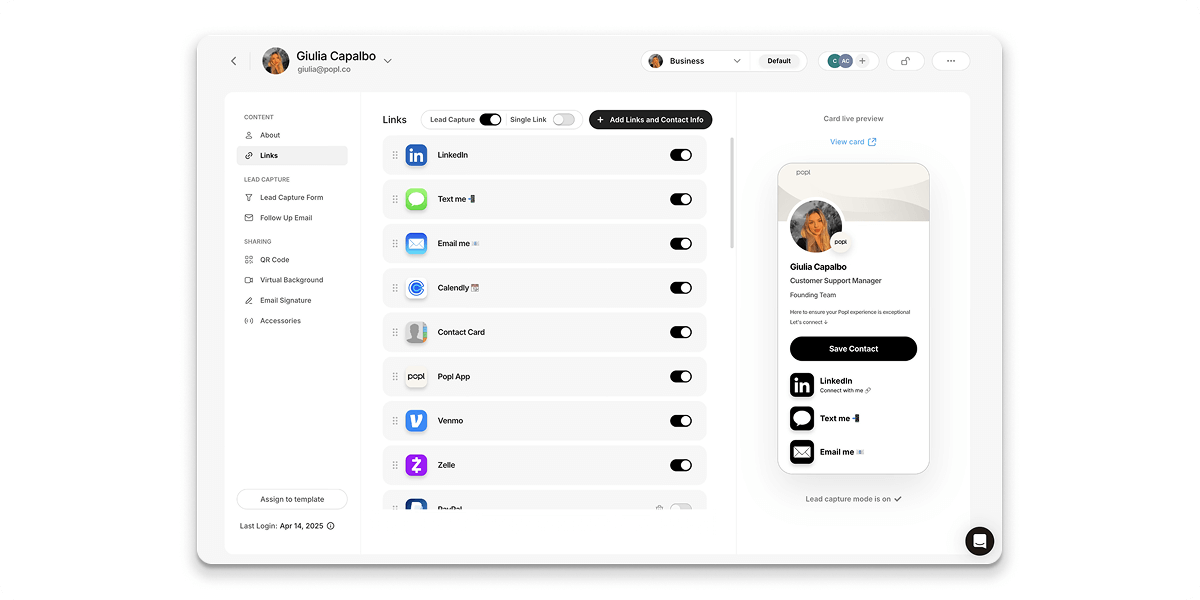
Team members can still personalize details like bios, links, and headshots—but the structure stays on-brand. For growing organizations, this control helps maintain a polished, standardized look across hundreds of profiles.
Contact sharing methods (QR, NFC, links)
Both platforms make it easy to share your card in person or online, giving users several ways to connect.
- QR codes: Available on both platforms, perfect for events, presentations, or printed materials.
- Shareable links: Instantly send your card via text, email, WhatsApp, or social media.
- NFC sharing: Popl provides NFC-enabled cards, tags, and wristbands that transfer contact info with a tap—no app needed on the recipient’s phone. HiHello, while compatible with NFC devices, doesn’t sell them directly, leaning into a more digital-first approach.
- Digital wallet integration: Both support Apple Wallet and Google Wallet, allowing users to store and present cards easily—even with offline functionality.
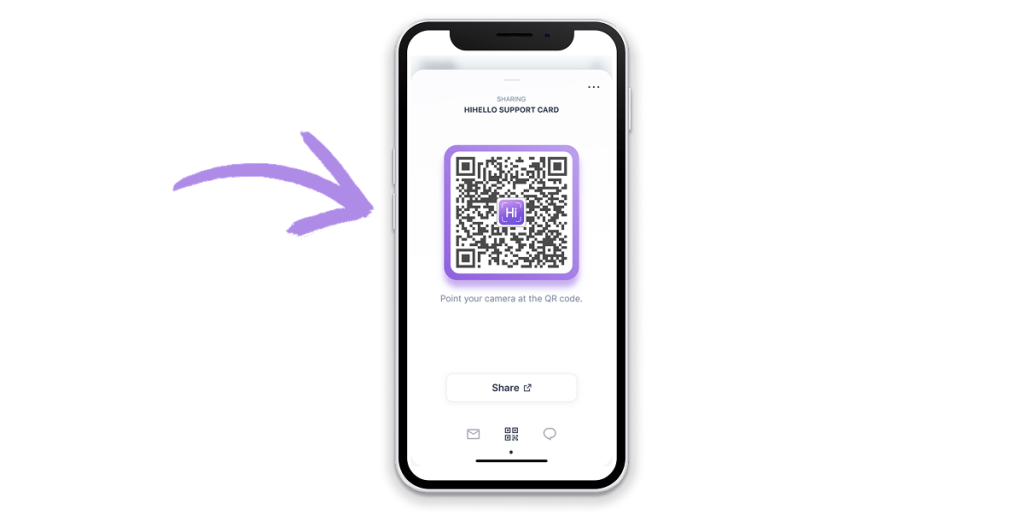
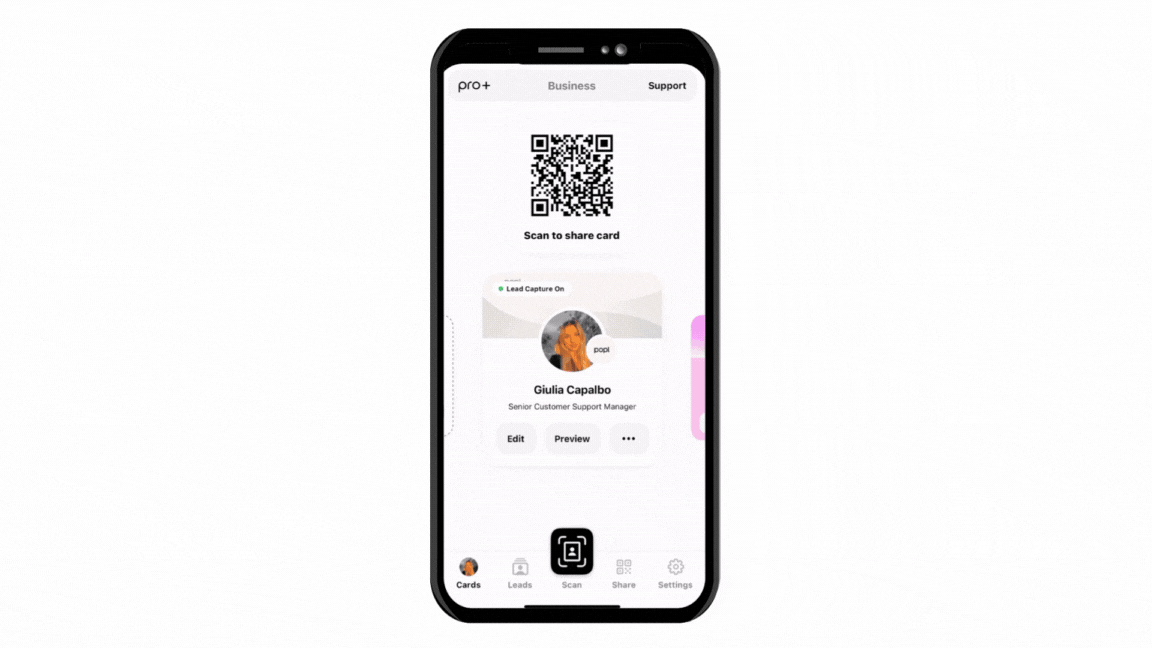
While both tools excel in accessibility, Popl stands out for its hardware options and offline QR mode. It’s ideal for busy networking events where Wi-Fi isn’t guaranteed.
Contact management and lead capture
Both Popl and HiHello transform networking into a structured, measurable process. They move far beyond contact storage, focusing on how teams capture, qualify, and convert leads.
Popl offers an AI-driven lead capture system designed for sales and event teams that rely on speed and accuracy. Using the mobile app, users can collect and enrich contacts instantly through:
- AI-powered badge and business card scanners that extract and verify details automatically.
- Custom lead forms with qualifying questions to capture intent and context.
- Automatic CRM syncing with Salesforce, HubSpot, and other tools.
- Calendar integrations that schedule meetings on the spot.
Every interaction becomes a complete, validated profile—helping teams shorten sales cycles and keep their pipelines full.
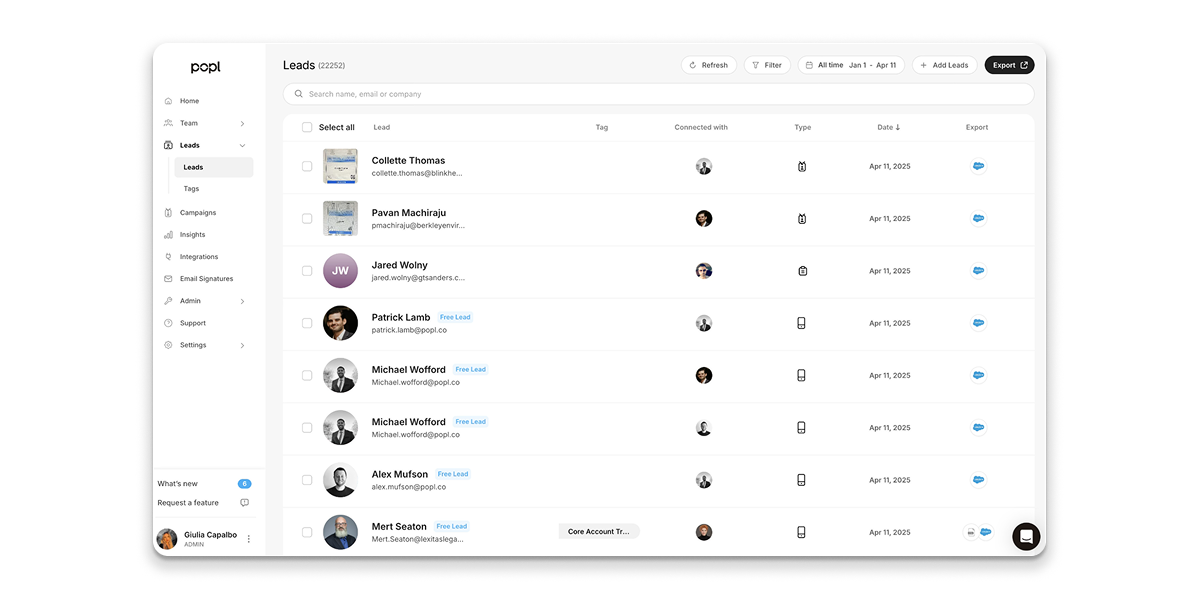
HiHello, in contrast, focuses on structured, compliant lead capture that maintains brand integrity. HiHello offers:
- Customizable capture forms embedded in each virtual business card, allowing recipients to share their details instantly.
- Real-time CRM integrations to sync data across Salesforce, HubSpot, and Microsoft Dynamics.
- Compliance controls for GDPR and HIPAA, including consent language and audit-ready tracking.
- Configurable fields that let admins decide exactly what information teams collect.
Analytics and insights
Popl’s analytics give teams visibility into activity and performance, showing:
- How many cards or leads each rep generates
- What sharing channels perform best
- ROI from specific networking events
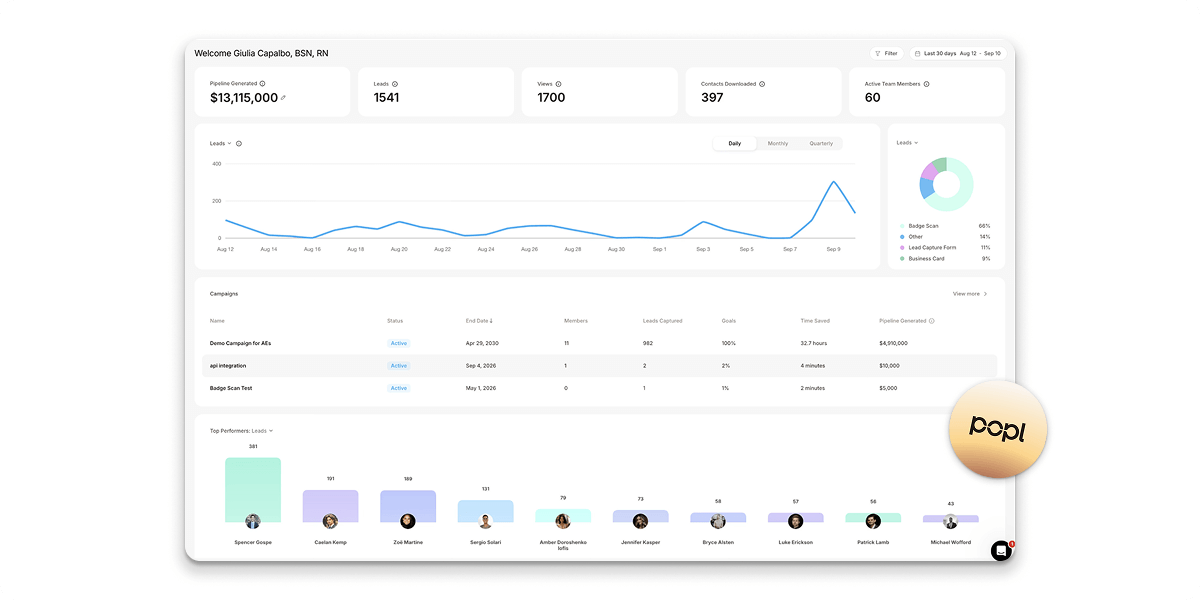
This data connects directly to CRMs, helping businesses measure how in-person efforts translate into results.
HiHello’s analytics focus on visibility and team engagement. Users can track views, shares, and saved contacts, while admins can monitor usage through leaderboards that encourage active sharing.
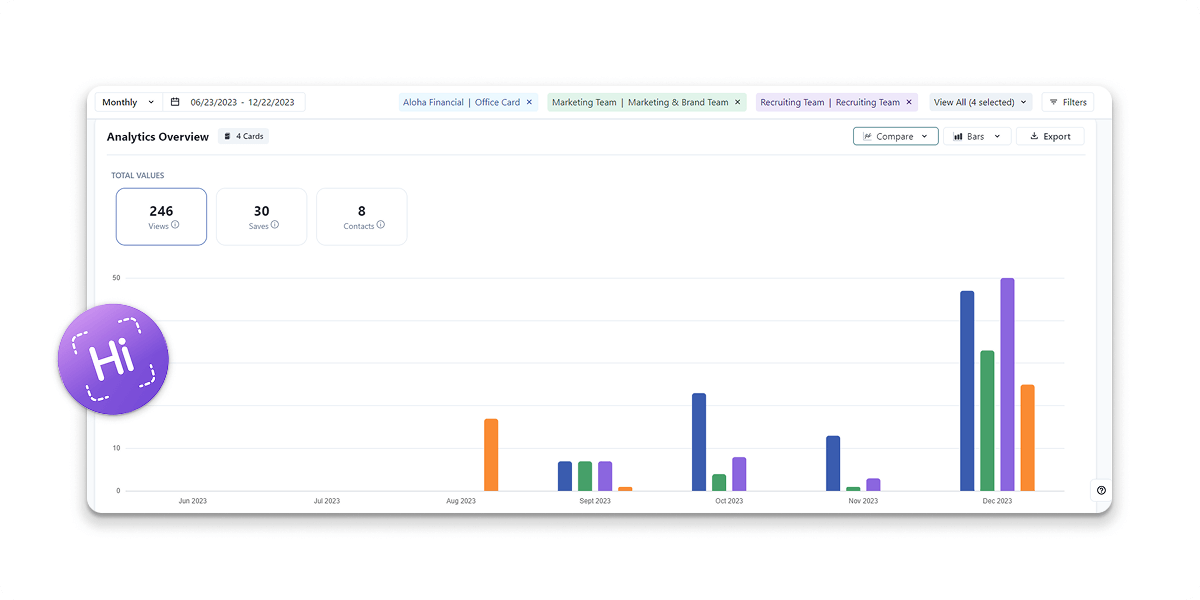
Both make it easier to understand how introductions turn into opportunities—but Popl favors performance tracking, while HiHello highlights interaction quality.
Unique tools in Popl and HiHello
Both platforms excel in digital networking but serve different priorities.
Popl is built for sales and event teams that need speed and measurable results. Its standout tools include:
- AI-powered enrichment for verified, CRM-ready contact data.
- Event Campaigns dashboard to track ROI across networking events.
- Lead qualification with voice notes and custom questions.
- Offline functionality and calendar integrations for real-time follow-ups.
Together, these features turn Popl into a complete event-to-CRM networking tool that captures new contacts, enriches leads, and helps to convert them.
HiHello focuses on brand consistency and digital identity across an organization. Its unique strengths include:
- A Professional Presence Platform combining virtual business cards, email signatures, and virtual backgrounds.
- A real-time Employee Directory and Brand Partner Program for distributed teams.
- HR integrations with systems like Workday and Okta for automated onboarding.
Popl provides automation and event-driven efficiency, while HiHello offers a cohesive, compliant platform for managing brand identity across every digital touchpoint.
Ease of Use
Both Popl and HiHello are known for being approachable, even for users new to digital business card tools. Yet, their setup, app usability, and recipient experience differ in a few key ways that are worth noting before making a decision.
Setup process and interface
Popl earns high marks for simplicity and guided onboarding. Out of more than 5,000 G2 reviews, nearly 2,000 specifically mention its ease of use, and over 1,300 highlight how easy it is to share.
Most users find setup quick—especially with its template-based team creation process. The dashboard is designed for administrators to manage cards, branding, and permissions without hassle.
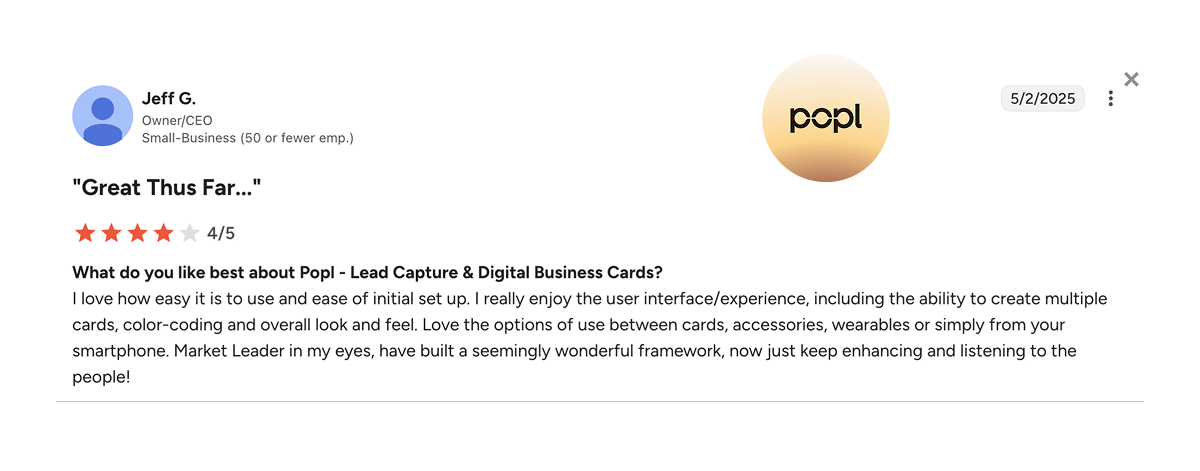
However, some reviews mention a brief learning curve for users unfamiliar with digital business card platforms, and a small number (188 reviews) note QR code issues during setup or sharing.
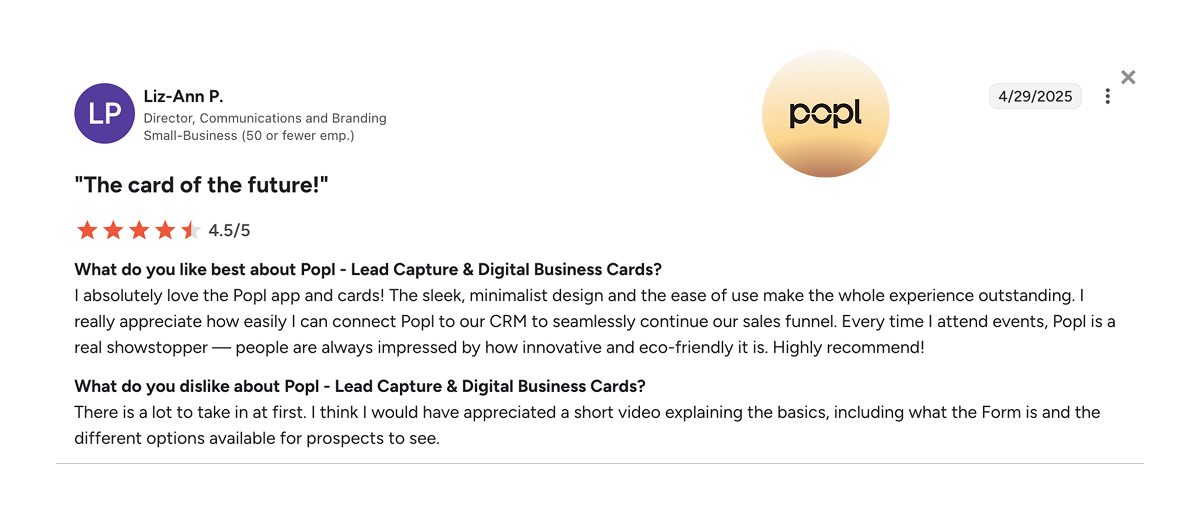
HiHello follows a clean, intuitive design philosophy. On G2, more than half of reviewers praise its convenience and ease of use, often noting that creating and personalizing cards is straightforward. The setup flow walks users through adding logos, links, and colors step by step.
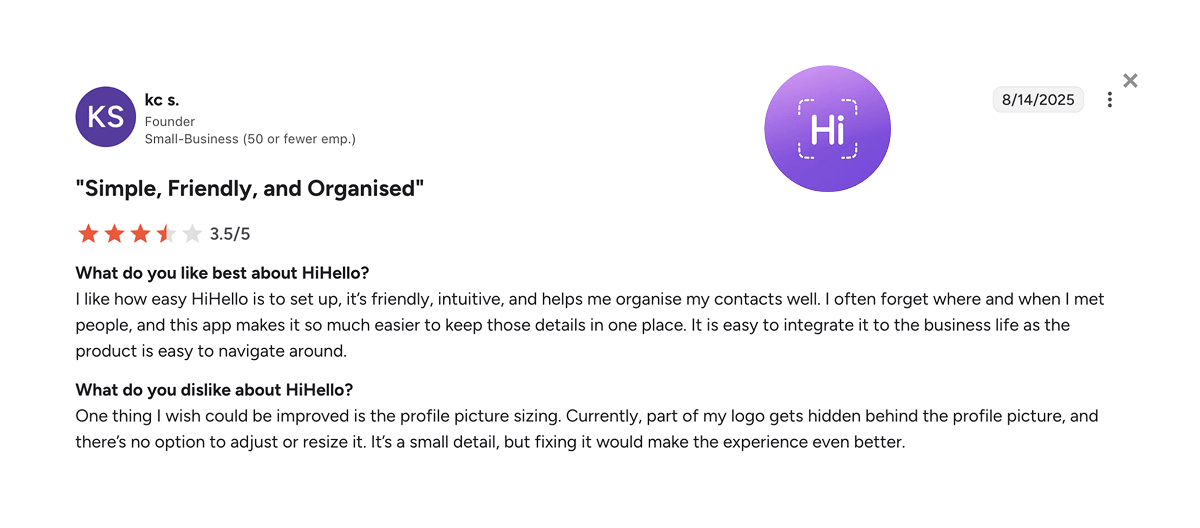
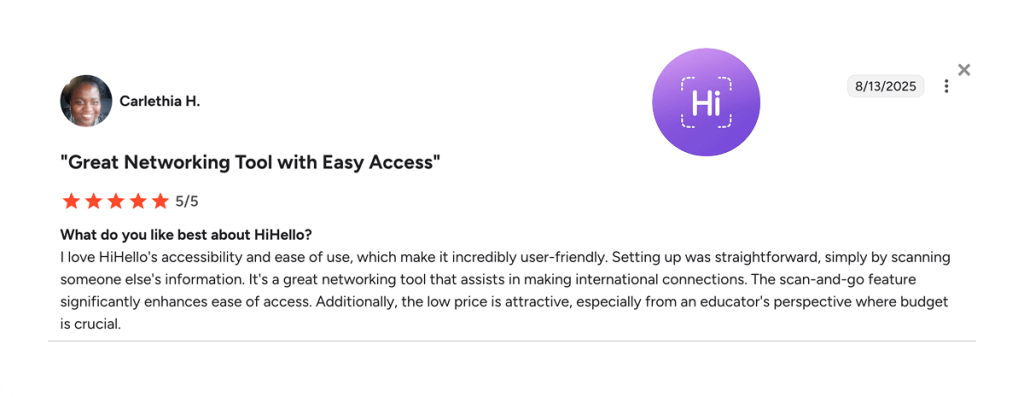
Mobile app experience
Popl’s mobile app is praised for reliability and smooth sharing at networking events. Users like the seamless syncing between the app and their digital wallet, though some note occasional syncing delays with the desktop dashboard.
Editing capabilities are comprehensive, but a few reviewers mention that certain adjustments—like advanced design edits—are easier to handle on desktop.
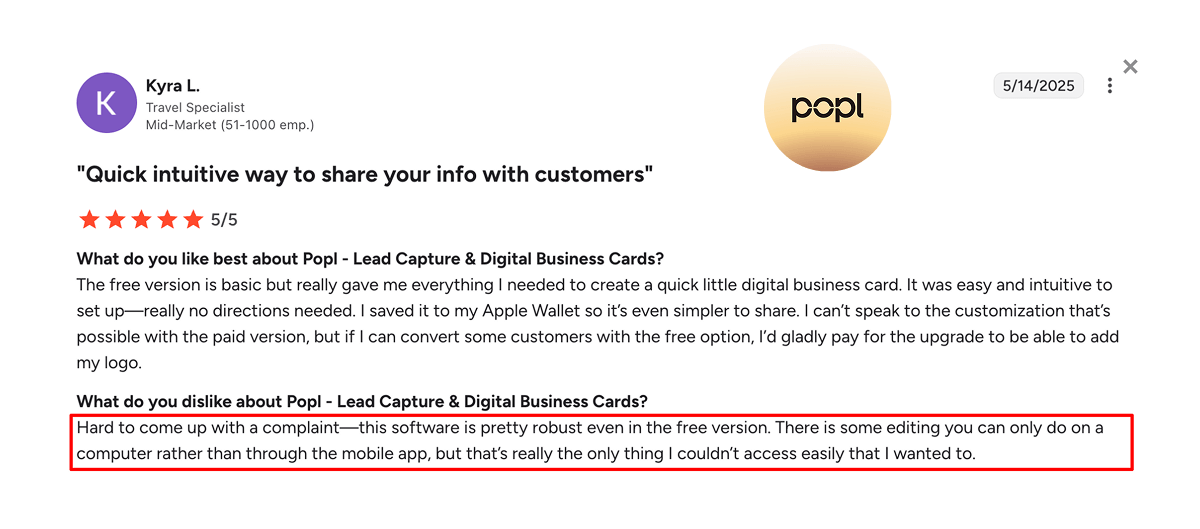
Like Popl, HiHello’s mobile app, too, receives consistent praise for its user-friendly interface and professional polish. Reviewers appreciate how the app keeps digital cards organized and instantly shareable through QR codes, text, or NFC.
However, some users mention occasional glitches and slower load times, while others point out that to save a card permanently to their device, they must download the app.
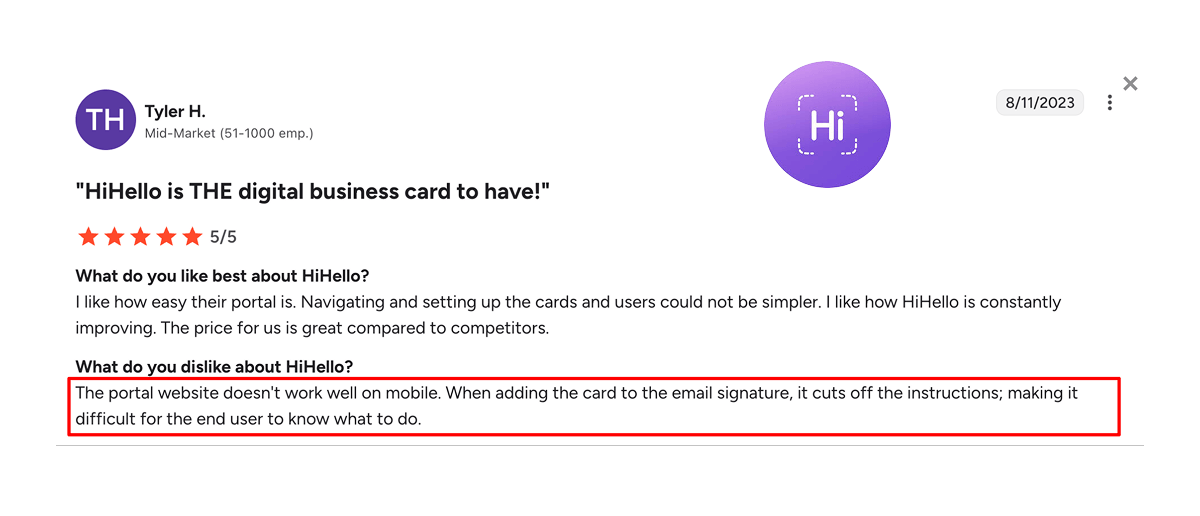
Recipient experience
Popl cards open instantly via tap or QR code, no app required. The layout is responsive and direct, giving quick access to contact buttons and social links. Most users describe it as fast and intuitive, though a few mention minor QR scanning hiccups at crowded events.
HiHello delivers a similarly smooth process—cards open in any browser or through a QR scan—but saving them to a digital wallet or device may require downloading the app. Despite that, reviewers praise its professional design and how easy it is to share across platforms.
In short, Popl provides faster access for recipients, while HiHello offers a slightly more polished, brand-consistent visual experience once opened. Both make connecting effortless for new contacts, ensuring that no lead—or introduction—ends up lost in translation.
Pricing
Both Popl and HiHello take a tiered approach to pricing, offering options for individuals, small teams, and enterprise-scale organizations. After evaluating usability and features, cost becomes the next deciding factor—especially for teams looking to balance functionality with budget.
Free plans
Both platforms provide free digital business card software versions aimed at individuals or small business owners exploring digital business card tools for the first time.
Popl’s free plan covers all the basics:
- Access to the mobile app
- Email signatures and virtual backgrounds
- Auto follow-up emails and texts
- Offline sharing via QR or NFC
It’s enough for simple sharing, though users can’t access CRM integrations or lead capture tools.
HiHello’s Personal plan also starts at no cost and includes:
- One virtual business card with full contact details, logo, and links
- Sharing via QR code, Apple Wallet, or widgets
- Email signature generator and virtual meeting backgrounds
- Limited business card scanner (5 paper card scans per month)
HiHello’s free plan is slightly more robust for personal branding, while Popl’s offers stronger automation even at the entry level.
Paid subscriptions and packages
Both companies use a freemium-to-enterprise model, with flexible pricing depending on team size and needs.
Popl offers:
- Pro: $7.99/month ($6.49 when billed annually)
- Pro+: $14.99/month ($11.99 annually)
- Teams and Enterprise: Custom pricing via sales
Upgrading unlocks CRM integrations, lead capture, analytics, paper business card scanners, and access to over 5,000 integrations.
HiHello offers:
- Professional: From $6/month billed annually (for individuals)
- Business: From $25/month billed annually (includes 5 users)
- Enterprise: Custom quote via sales
Higher tiers add multi-user management, CRM sync, team-wide email signatures, analytics, and unlimited card scans.
Value for money
In terms of cost-to-feature ratio:
- Popl provides stronger value for event-heavy teams that need lead capture, CRM automation, and offline functionality.
- HiHello offers more polished branding tools, cross-platform design control, and scalable team management at competitive rates.
For individual users, HiHello’s lower entry price and creative flexibility stand out. For growing teams, Popl’s automation and event-focused toolkit make it the better investment. Both platforms deliver fair value—your choice depends on whether you prioritize marketing efficiency or brand consistency.
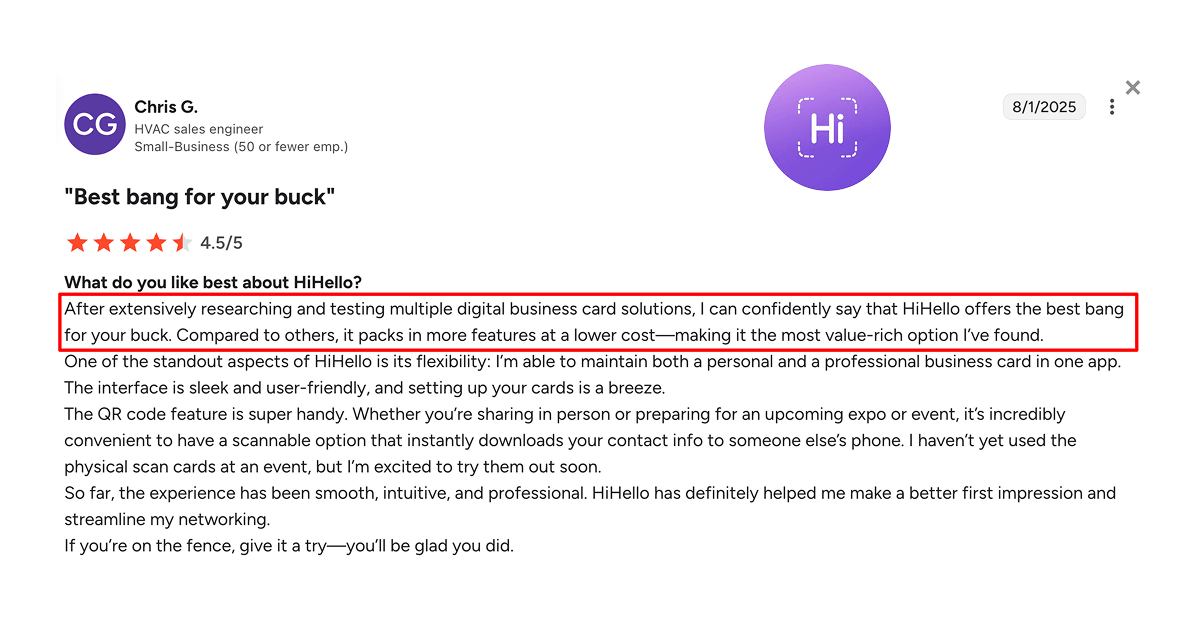
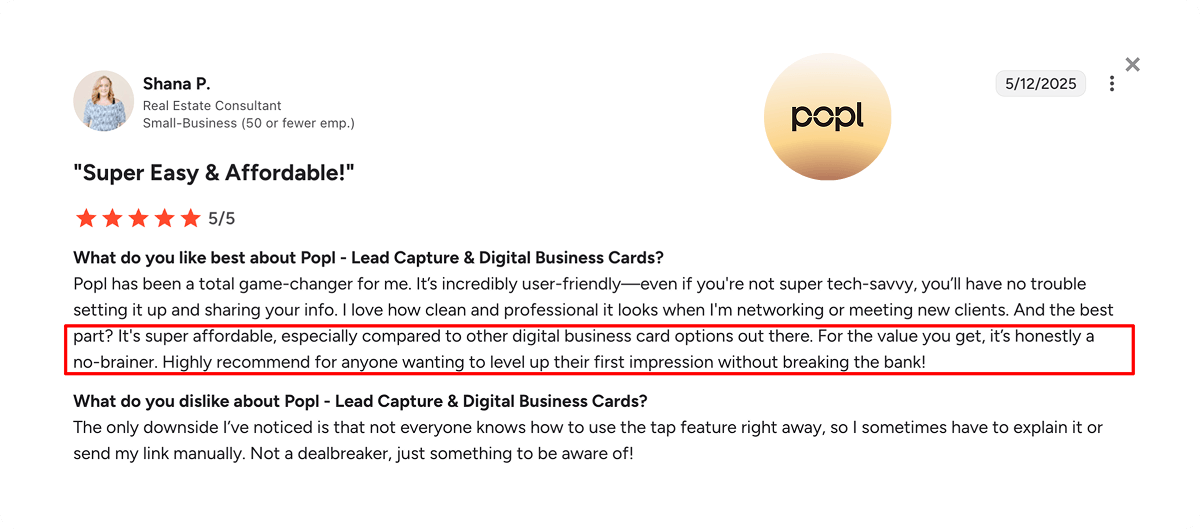
Integrations and Compatibility
Both Popl and HiHello are built to fit naturally into modern business ecosystems. Let’s look at how they work across platforms and devices, which marketing stack tools they connect with, and how they treat security and data privacy.
Platforms and devices
Both tools work across web and mobile apps, available on iOS and Android. Popl provides seamless syncing between its dashboard and app, optimized for team management on desktop and quick sharing on mobile. It also integrates with digital wallet platforms like Apple Wallet and Google Wallet for instant access.
HiHello offers equally strong cross-device compatibility, letting users create, share, and update cards from any browser or smartphone. Its cards display perfectly across devices, whether shared through QR, NFC, or links—making it easy to stay connected anywhere.
CRM and business integrations
Both platforms prioritize CRM and HR connectivity, but their focus differs slightly.
Popl integrates with Salesforce, HubSpot, Outlook, and over 5,000 additional tools through Zapier. It also syncs directly with HR systems for automated team setup and provides an open API for custom workflows and marketing triggers.
Like Popl, HiHello integrates natively with CRM solutions like Salesforce, HubSpot, but also Microsoft Dynamics, Google Workspace. It also connects with marketing tools like Marketo and Mailchimp.
Beyond CRM, it connects with identity and HR systems such as Workday, Okta, and Entra ID to streamline onboarding and team management.
Security and data privacy
Popl stands out with SOC 2 Type II certification, GDPR compliance, encryption at rest and in transit, and secure SSO authentication. It allows centralized access control for large organizations managing sensitive data.
HiHello matches this level of protection with SOC 2 Type II compliance, GDPR and CCPA readiness, and advanced role-based permissions. It also supports SSO, SAML, and SCIM for identity management.
Customer Support and Reliability
When choosing a digital business card platform, responsive support and dependable performance can be just as important as sleek features. Here’s how Popl vs HiHello measure up when it comes to helping users and maintaining trust at scale.
Popl vs HiHello support options
Popl provides around-the-clock assistance for paying customers, including 24/7 chat and email support, plus a growing knowledge base covering setup, integrations, and event workflows. Enterprise clients receive onboarding help and custom admin guidance for team deployment.
HiHello offers in-house, U.S.-based customer support, which reviewers frequently describe as “responsive” and “knowledgeable.” Its Customer Success team handles onboarding, live demos, and training sessions for business and enterprise users. For individuals, the Help Center and email support cover most needs effectively.
Both make it easy to get answers quickly, but HiHello’s more personal approach gives it a slight edge for teams looking for guided partnership, while Popl’s around-the-clock availability benefits global or event-driven organizations.
Reputation and user reviews
Across review platforms, both tools maintain strong reputations, with thousands of users rating them highly for usability and reliability.
Popl leads in volume with over 5,300 G2 reviews, boasting an impressive 4.6/5 average rating. Positive feedback centers on ease of use (1,981 mentions), convenience (1,846), and sharing ease (1,370). However, some users mention downsides such as pricing (385) and additional costs (256), alongside limited customization (229) and QR code issues (188).
[Alt: A screenshot of Popl’s G2 rating breakdown]
HiHello, with 725 reviews and a matching 4.6/5 rating, earns similar praise for ease of use (424), convenience (230), and easy sharing (197). Minor frustrations include limited customization (49), missing features (40), and a few mentions of QR code issues (39) or pricing concerns (34).
[Alt: A screenshot of HiHello’s G2 rating breakdown]
Company reliability
Both companies have proven staying power in the digital business card market. Popl leads in scale with over 2.5 million users and adoption across 90% of Fortune 500 companies, backed by SOC 2 Type II security and steady innovation in AI-powered tools.
HiHello, launched in 2018, serves 2 million users worldwide and partners with global brands like Google and Meta, earning a reputation for reliability, consistent updates, and strong compliance.
Pros and Cons
Both HiHello and Popl excel in different areas. Your ideal choice depends on what matters most: brand control, automation, or event-driven lead generation. Here’s how they stack up.
Pros and cons of HiHello
| Pros of HiHello | Cons of HiHello |
| Highly customizable digital business cards with branded designs, colors, and layouts | Some users find the interface overwhelming at first |
| Combines virtual business cards, email signatures, and meeting backgrounds in one platform | Limited NFC support (no in-house hardware) |
| Smooth CRM integrations with Salesforce, HubSpot, and Microsoft Dynamics | Occasional app slowdowns or glitches |
| Enterprise-grade security with SOC 2 Type II and GDPR/CCPA compliance | Fewer lead capture tools compared to Popl |
| Built-in compliance features for regulated industries (HIPAA, GDPR) | Must download the app to save cards permanently |
| Excellent in-house, U.S.-based customer support | Lower card-scanning limits on entry plans |
Pros and cons of Popl
| Pros of Popl | Cons of Popl |
| Fast, reliable NFC and QR-based sharing for networking events | Higher pricing on advanced tiers |
| Powerful AI-powered lead capture and CRM automation | Some users report QR code issues |
| Integrates with 5,000+ apps via Zapier and built-in connectors | Limited design flexibility compared to HiHello |
| Offline functionality and mobile-first design | Small learning curve for new users |
| Team analytics, event ROI tracking, and enriched lead data | Physical NFC products add to total cost |
| Enterprise-grade security with SOC 2 Type II certification | Admin dashboard can feel complex for small teams |
Which digital business card platform is best for your network?
If you value brand control, design flexibility, and compliance, HiHello is the smarter pick. For automation, lead capture, and event-driven scalability, Popl provides the stronger solution. Your network’s priorities (style or speed) will decide the winner.
Popl vs HiHello Is Clear—Now Meet Their Powerful Alternative: MySignature
Popl and HiHello both do a lot right, but professionals often need something simpler, more unified, and budget-friendly. MySignature delivers exactly that—a balanced, modern way to share contact details, manage your brand, and streamline communication without extra complexity.
With MySignature’s Digital Business Card, you can create a custom card in minutes, store it on your phone, and share contact information instantly via QR code, NFC, or link. It combines professional branding, smart integrations, and automation in one intuitive platform.
If you want even more flexibility in how you share your details, you can use the MySignature QR code generator to instantly create a scannable code.
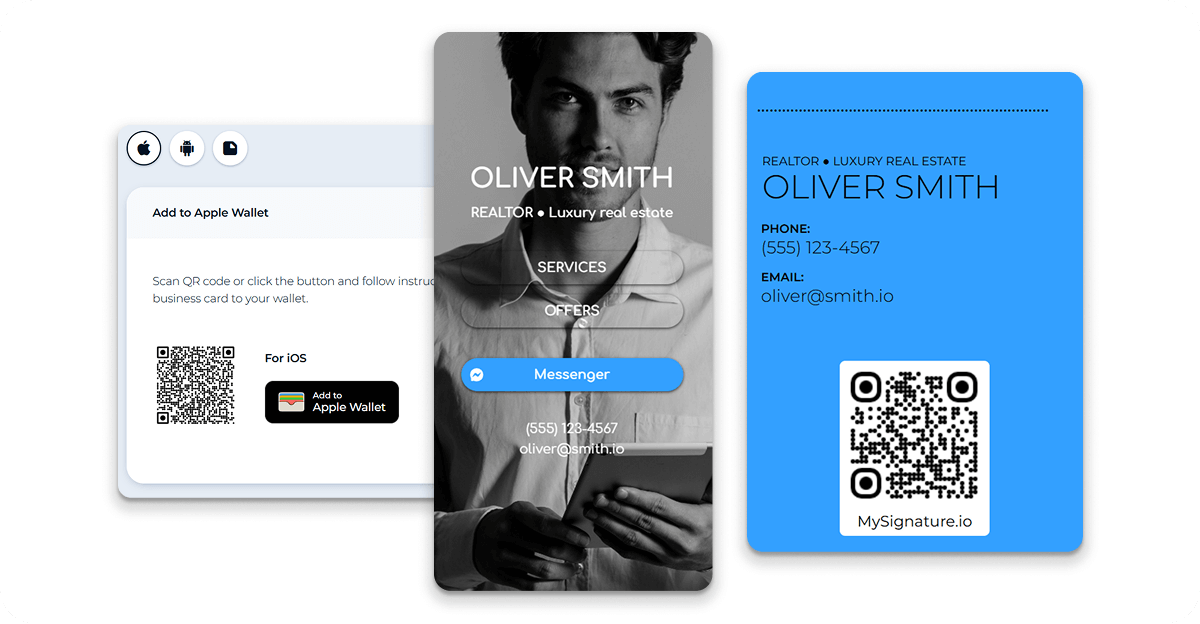
Why teams choose MySignature over platforms like Popl and HiHello:
- All-in-one contact hub with up-to-date links, social profiles, and details.
- Google Workspace and Microsoft 365 integrations for seamless team management.
- Built-in branding tools like email signatures and link-in-bio pages.
- A reliable lead generation channel that turns every connection into an opportunity.
- Affordable and sustainable—starting from $0.91 per member/month.
MySignature helps you make stronger, more consistent connections—combining simplicity, speed, and brand control in one powerful platform. Give it a try!
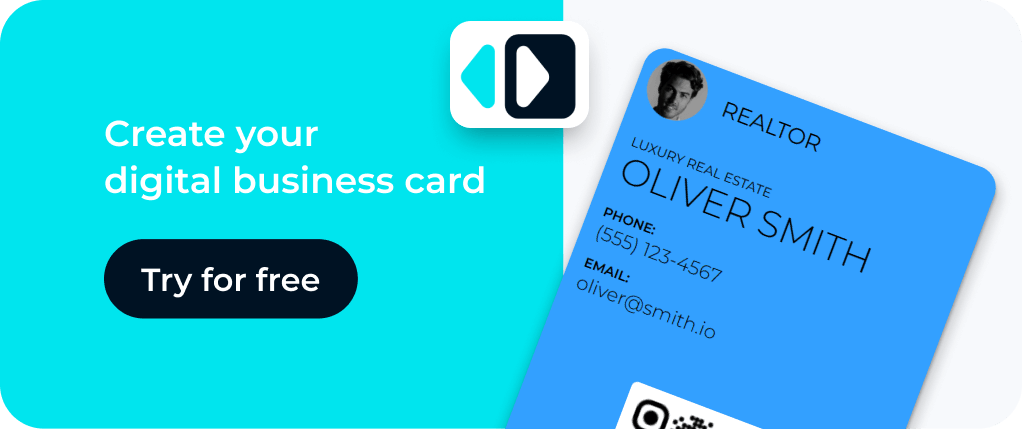
FAQ
How does Popl differ from HiHello as a digital business card platform?
Popl focuses on automation, AI-powered lead capture, and event-driven networking, making it ideal for sales and marketing teams. HiHello, on the other hand, emphasizes branding, compliance, and design flexibility, better suited for organizations prioritizing professional presentation and internal control.
Do recipients need an app to save or access my card?
No. Both Popl and HiHello let recipients open and save your card via QR code, NFC tap, or link—no app download required. However, saving a HiHello card to a digital wallet may require the HiHello app.
Which platform offers better features for networking?
For large events and team-based lead collection, Popl provides stronger networking tools, including real-time lead capture, CRM sync, and analytics. HiHello suits professional networking focused on brand consistency, custom design, and ongoing relationship management.
How to choose the best digital business card for my needs?
Start with your goals. Choose Popl if you prioritize automation, CRM integration, and team-wide visibility. Choose HiHello if you value custom branding, simplicity, and compliance. For a more balanced option, consider MySignature, which blends both approaches with built-in email signatures and affordable team plans.
Can I update my card information after sharing it?
Yes. Both platforms allow real-time updates—when you edit your card, your shared link or QR code automatically reflects the latest details.
Are Popl and HiHello compatible with CRM or other business tools?
Yes. Both integrate with major systems like Salesforce, HubSpot, and Microsoft Dynamics. Popl connects to 5,000+ apps via Zapier, while HiHello offers direct integrations with CRMs, marketing platforms, and Google Workspace for streamlined contact management.


